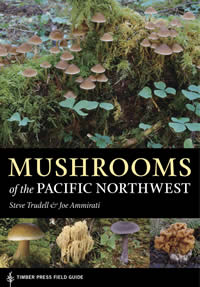Our backyard (which is flat and no pine trees) has hundreds of tiny mushrooms throughout the grass. Our front yard (which has a slight slope and one large pine tree) has many huge mushrooms. Otherwise, we have good looking grass. We have lived here for a very long time without ever seeing this problem. I know one answer is to “sweeten” the soil with lime. Should we do this now, in the fall, or at what time of year? Should we remove the mushrooms or let them be? Any other suggestions?
University of California, Davis Integrated Pest Management has guidelines on managing mushrooms in lawns. Here is an excerpt:
“Mushrooms found in lawns often develop from buried scraps of construction lumber, dead tree roots, or other organic matter. The fungi that produce these mushrooms are beneficial because they decompose organic matter in the soil, making nutrients available to other plants. These mushrooms usually are harmless to grasses, but some people consider them unsightly or want to get rid of them because young children play in the area. Remove mushrooms growing from buried wood or roots by picking them as they appear or by digging out the wood. Many of these mushrooms are associated with overirrigation or poor drainage. Removing excess thatch and aerating the soil to improve water penetration may help in some cases.”
The website further suggests adding nitrogen fertilizer, but bear in mind that excessive fertilizer contributes to urban runoff pollution.
As for sweetening the soil with lime(making it less acidic), it is best to do a soil test before attempting to amend for soil pH. The City of Seattle’s Natural Lawn Care information says that you would only need to “apply lime in the spring or fall if a soil test shows a calcium deficiency or acid soil conditions (pH less than 5).”
I have a potted plant with a fungus growing in the soil. It
is bright neon yellow and grows like a mushroom, but with no cap on top.
The plant is in the basement near a window. The soil is damp and I’ve
avoided watering for awhile to let it dry out. What do you think the
growth is, how to get rid of it, and will it be harmful to my plant? I
keep plucking them, but they grow back.
I have had questions about the yellow houseplant mushroom before, and I
am guessing you are seeing the same thing. It is called Leucoprinus
birnbaumii.
Michael Kuo’s website, MushroomExpert.com has information about Leucoprinus. Excerpt:
“This little yellow mushroom and its close relatives are the subject of
many frantic e-mails to MushroomExpert.Com, since it has a tendency to
pop up unexpectedly in people’s flower pots–even indoors! The brightness
of its yellowness exhibits some rebelliousness, but it often creates a
striking contrast to the green houseplants that surround it.
“Leucocoprinus birnbaumii won’t hurt you, unless you eat it. It won’t hurt
your plant. It won’t hurt your pets or your children, unless they eat it.
There is no getting rid of it, short of replacing all the soil in your
planter (and even then it might reappear). Since it makes such a
beautiful addition to your household flora, I recommend learning to love
it–and teaching your children to love it, too.
“You might also impart the idea that mushrooms are very, very cool–but
shouldn’t be eaten. Perhaps your child would like to become an awesome
and famous mycologist some day. I would love to encourage your child’s
interest in mushrooms by putting his or her drawing of Leucocoprinus
birnbaumii on this Web page (at least temporarily).
“Leucocoprinus birnbaumii is probably poisonous; do not eat it. Handling
it, however, won’t hurt you.”
A list of the best books, articles and websites on mushrooms.
PSMS is “an organization of people interested in mushrooms and mushrooming, which provides support and encouragement for research, education, cultivation, hunting, identifying, and cooking mushrooms.”
The Museum’s Botany collection holds an estimated six million specimens of mosses, ferns, seed plants and slime molds from all over the world. The botanical collection spans a period from the 17th century to the present and includes a number of historically important collections.
 “Mushrooms of the Pacific Northwest” is another in the fine series of Timber Press Field Guide. Like earlier works on wildflowers and insects, it’s well designed to be a good field companion with a coated cover, a ruler on the back, and frequently needed facts easily found on the inside covers.
“Mushrooms of the Pacific Northwest” is another in the fine series of Timber Press Field Guide. Like earlier works on wildflowers and insects, it’s well designed to be a good field companion with a coated cover, a ruler on the back, and frequently needed facts easily found on the inside covers.
Particularly good is the long introduction which addresses subjects from the ecology of mushroom-fungi, the hazards of hunting in the Pacific Northwest, to “How to avoid becoming a poisoning statistic.” Unlike many field guides, the text in the descriptive encyclopedia is in narrative form, rather than having set descriptive elements for each species. Not being a mushroom hunter, I can’t vouch for the effectiveness at identification by this approach, but I found it enjoyable reading.
Excerpted from the Fall 2010 Arboretum Bulletin.
 “Mushrooms of the Pacific Northwest” is another in the fine series of Timber Press Field Guide. Like earlier works on wildflowers and insects, it’s well designed to be a good field companion with a coated cover, a ruler on the back, and frequently needed facts easily found on the inside covers.
“Mushrooms of the Pacific Northwest” is another in the fine series of Timber Press Field Guide. Like earlier works on wildflowers and insects, it’s well designed to be a good field companion with a coated cover, a ruler on the back, and frequently needed facts easily found on the inside covers.